Look at Charles and Deanna Farish today and it’s hard to imagine them homeless. Both are 51 years old. Their eyes sparkle and their faces radiate happiness — but it was only three years ago that they both saw no way out of the park they were living in.
Charles and Deanna met in Mellis Park, in Modesto. Both were homeless and single. Except when rousted by the police, they stayed in the park for two years, until local authorities opened Beard Brook Park for permitted camping in 2018.
They both used drugs. Charles had started with cocaine in high school, following the example of his drug-using father. Deanna didn’t start using until she was in her forties.
Diagnosed as bipolar, she had stopped taking her prescription medication. “I treated my mental illness with dope,” she said recently, “and dope makes mental illness worse.”
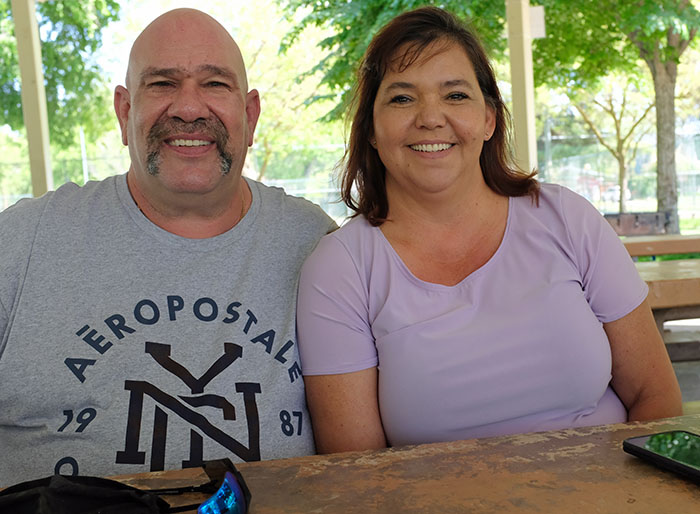
Once homeless, methamphetamine (meth) became the drug of choice for both of them. In part because it’s cheap and widely available, meth is the preferred drug for most homeless people who use. Another reason they choose meth is that homelessness, “is scary,” according to Deanna.*
“You don’t know who’s going to creep up on you. You’re always asking yourself, ‘Where am I going to eat tomorrow.’”
A powerful stimulant, meth helps keep people awake and alert; it also suppresses appetite. A sleeping homeless person is constantly subject to theft. Some have had their shoes taken off their feet while slumbering. They’re also subject to rousts by the police, harassment from angry citizens and young bullies, and visits by foraging rats, possums, and raccoons.
One homeless man, when asked about the biggest challenges of homelessness answered, “You’re always alert,” and, “You’re always around crazy people.” Hence the popularity of methamphetamine, a drug that helps keep people awake and on edge.
A Place to Stay
Things began to change for Charles and Deanna when City of Modesto authorities permitted camping at Beard Brook Park in the city’s industrial area in late fall of 2018. Permitted camping came about as the result of a court ruling that cities and counties couldn’t penalize people for sleeping in public places if there were no other options for shelter. Beard Brook Park became known as Beard Brook Village.
For Charles and Deanna, one of the immediate benefits of having a place to stay was a chance to catch up on their sleep. Suddenly, they didn’t have to fear loss of their possessions or forced relocations.
They also benefitted from a sense of community. Homeless people feel safer when among groups of friends. Like communities everywhere, they have their own cultural standards, some of them peculiar.
“The person who stole your bike might help you look for it,” laughed Deanna, “even while he’s got the money from selling the bike in his pocket.”
Petty theft among the homeless, among other infractions, is forgivable only as long as it’s made up for. Like many poor people, rather than call in authorities, the homeless prefer to handle more serious problems their own way. It’s often referred to as “park justice.” Bullies, abusers, and unrepentant thieves are ostracized and kept out of the community, often by force.
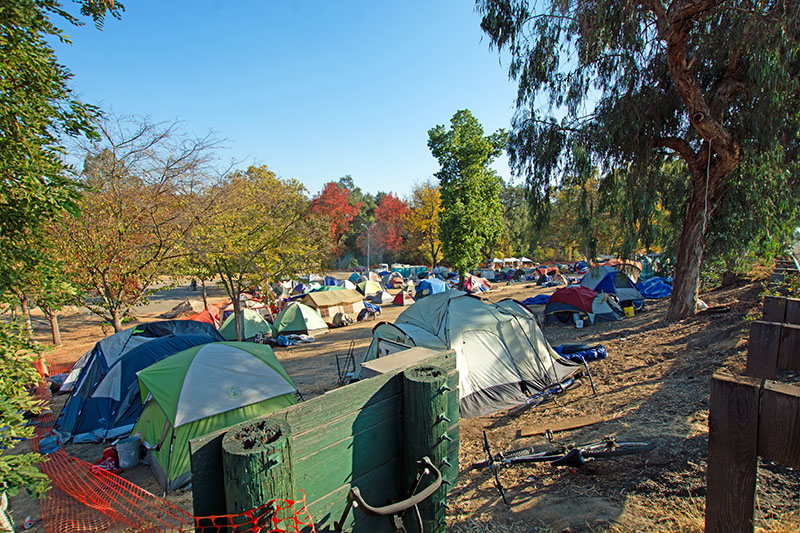
Early in 2019, when Beard Brook Village was moved to what became the Modesto Outdoor Emergency Shelter (MOES) near the Salvation Army’s Berberian Shelter, Charles and Deanna felt even more secure. They were joined by Charles’ mother, whose fixed income was too low to afford rent. She took a tent next to theirs.
“It gave us a sort of a foundation, and a little bit more hope,” said Deanna. “The people in the trailer like Christina Kenney were wonderful.”
“The trailer” was an onsite trailer staffed with people who provided counseling and advice. Much of the help was in addressing basic needs such as obtaining driver’s licenses and birth certificates, both of which most homeless people seldom have in their possession. Christina Kenney was one of several county workers who helped staff MOES.
The People
In addition to Christina Kenney, Charles and Deanna discovered several other friendly benefactors at MOES. Red Hawk, a staff worker who seemed to be everywhere at once, became a trusted friend and positive influence.
“He had AA (Alcoholics Anonymous) and NA (Narcotics Anonymous) meetings every night,” said Deanna. “We started going every night.”
Another supporter was Joseph Dean Dodd. Charles and Deanna knew Dodd both as the Pastor for Church in the Park as well as the guiding spirit for Church in the Park’s Shower Shuttle.
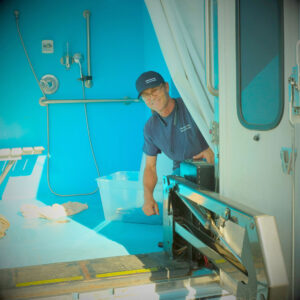
“Every time we got a shower and clean underwear and socks at the Shower Shuttle, we got a little bit more hope,” said Deanna. “Pastor Dean doesn’t judge, he just helps,” said Deanna of Dodd, who is widely admired for his humility and service to the poorest of the poor.
Charles credits Dodd’s spiritual guidance for bringing him to faith in God. “Once I gave myself to God, everything got better,” he said.
Once at MOES, both Charles and Deanna began noticing other people’s behavior. “Everyone was acting crazy and fighting over drugs,” said Charles. “Then I realized I was acting the same way. I didn’t want to be like that.”
Unbeknownst to Charles, Deanna had been writing in her journal about quitting drugs. One day Charles said, “I’m ready to quit. Are you ready?” Deanna said she had been ready before he was.
One of the first people they told about their decision to quit was Modesto Police Sargent Mike Hammond, the lead officer for law enforcement at MOES.
“He’s the kindest, most compassionate person there is,” said Deanna. “He cares about people, the community…he cares about everything. There’s not a cold bone in that man’s body.”
Hammond is widely known among homeless people as a tough cop who prefers to help people rather than arrest them. At MOES, many viewed him as a guardian — the big brother everyone wishes they had when trouble comes.
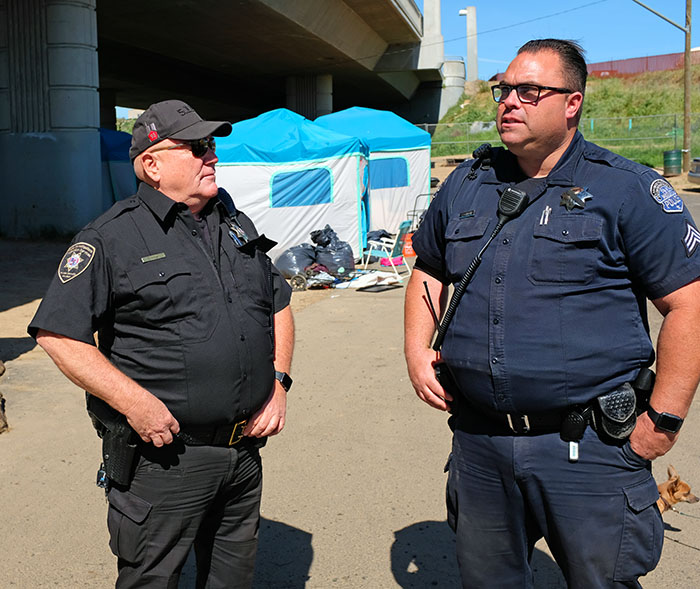
With a physique that enables him to subdue drug-crazed men capable of doing push-ups with over 300 pounds of cop and equipment on their backs and the temperament of a social worker, Hammond became both friend and supporter of Deanna and Charles, even before they decided to quit drugs.
“He checked on us almost every day he was at MOES,” said Deanna. “He kind of held us accountable.”
Quitting was difficult, even with the moral support of friends like Mike Hammond and Red Hawk.
“We mostly slept every day for about two weeks,” said Deanna. “Charles’ mom took care of us. She woke us up once or twice a day to feed us.”
Once off drugs, Charles and Deanna started thinking ahead. They wanted a future. They wanted out. Greg Pensinger showed them a path.
The Path
Greg Pensinger is the Director of the Stanislaus County Downtown Streets Team (DST). Originating in the Bay Area, the Downtown Streets Team is staffed by volunteers who are “homeless or at-risk of becoming homeless.” DST volunteers engage in cleanup and beautification projects.
People experiencing homelessness often become dissocialized. They lose track of time, fail to keep appointments, and have difficulty focusing and following through on simple tasks and intentions. The Downtown Streets Team is designed to “provide homeless and low-income people with the resources they need to rebuild their lives.” Volunteers are held accountable and rewarded for improved performance
One of the innovative features of the Streets Team is the practice of paying people with coupons and gift certificates good only for basic necessities like food and clothing. The program is designed to last a year, with the purpose of moving participants into regular employment. Charles and Deanna were the first graduates of the program.
“Greg helped us with our work ethic,” said Deanna. “Now I even have a résumé.”
“The Downtown Streets Team is why we are where we are today,” said Charles.
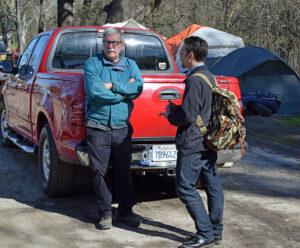
Today, Charles and Deanna are married and employed. Charles works for Stanislaus County at the low-barrier Berberian Shelter in Modesto. Deanna works in retail, at a local department store. They’re also housed.
“At first we lived with some other people in the Airport District,” said Charles, “but they started using drugs and it all came apart.” Ultimately, once they were both employed, Charles and Deanna were able to share a house with Charles’ mother. The three formerly homeless residents of MOES now live in Modesto.
When Charles is asked what would most help homeless people, he says, “Housing.” He then adds, “Housing and rehabilitation, both with drugs and mental health.”
Charles says that most of the homeless people he works with have varying degrees of mental illness that drugs make worse, yet few are motivated to change. Because she had a strong support system, Deanna began taking her prescribed medication even before she quit using. The medication was a major factor in her escape from homelessness.
Charles and Deanna, like most people on the streets, once shared whatever they had with other people in the same situation, including their drugs.
“Whenever people had drugs, they shared them,” said Deanna. “That’s just the way things were.”
“We still share,” said Charles, “but now we share different things. Sometimes if we see somebody hungry we can buy them a burger.”
Reflecting on homelessness and the people she has met along the way, Deanna said, “Most of us are good people. We have our bad moments, but most of us are good-hearted. Most people are good.”
*Video interviews with Charles and Deanna by Richard Anderson are here, and here.

I am so very proud of theses two I meet them when me and my husband volunteered down at MOES.. They have always worked so hard to keep to there goals they both have really big hearts always wanting to give back to the people. I have the pleasure of working with Charlie at the Shelter.
Great testimony. Very proud of both of you. Glad you found each other. It’s tough doing it alone.
This is my brother and sister I am so proud of you guys I am so proud of them they have come a long way they have become God’s children and I am so proud of them and that’s all I have to say God has them and God is good
That is a really an encouraging story. Some situations seem so hopeless. We know our God can and will help anyone.
Yes I know the couple very very well in fact I was homeless with them when I was pregnant with my daughter Charlie always came to inspire and motivate and Deanna being a proud supporter. I’ve always appreciated you guys and the time that we’ve had to be able to share.
Thank u.
Your friend,
Anna Bates
Great story, Eric!
I can remember being at Moe’s with. And standing there with Redhawk when everyday they would come to the trailer and said 7 days clean. Then it was we have 30 days. And I work with Charlie and know both them. I’m so very proud of the both of them.
Love u guys
Tamran
Very well written account; Thank you, Eric..
There has to be a narrative of success for others.
Thank you Charles and Deanna for your sharing, without holding back any of the truths. People need to understand, a day or days in, the life of some homeless individuals and couples. You touched on many different topics that the typical housed person has no experience with.
That is a good thing, YET, at the same time, it is precisely the lack of experience, that can tend to shelter people from knowing how it can begin, knowing what it can be like through the tough days, or knowing that with the right support, those who become homeless can, and do, become stable again and housed again.
People need hope, especially the homeless, BUT also the sheltered who are on the outside peering in. Hope that even in the overwhelming grind of drug usage, mental challenges and lack of safety issues, people can be lifted up, by sheer will to do so, and/or by others, who care enough to get in and remain involved, despite how hopeless it appears.
Yes, we walk by faith, not by sight. Because of you, two, now one, we have been introduced to others, by name and photo, that we may not have ever met. Through your hearts’ sharing, we now know things about people who share their concern, in ways we may have never known, otherwise.
Lets hold out much hope that multitudes more make it out of conditions: many of which were and are initiated and maintained by others (such as by being self-centered) who could have prevented the worst, THOUGH did not, for no good reasons… May we all be more humble…and open hearted, in order to, now, do what we can to prevent situations from worsening…
I am so proud of them.
Deanna has been a positive role model for me as well.
My brother Charlie and my sister-in-law Deanna along with my mom Diane I’m so proud of all of you being homeless is horrible but you guys pulled through it bright and shiny I’m so proud of you guys and I love you all one day at a time
Charlie and Deanna have been such an inspiration for me. I first met Charlie at Gracaeda Park several years ago when I was still with my ex-boyfriend. He was always a gentleman towards me, unlike a lot of other homeless men. I met Deanna for the first time at MOE’S when the tent she and Charlie shared together was right across from mine and my daughter’s tent.
Charlie and Deanna got clean in amongst nothing but a sin city of drugs and drama. They stuck with it and now have 2 years clean I often asked myself, “How did they do it!” My amazement and non-stop encouragement from them have eventually lead to my recovery. I joined the Downtown Streets Team and through them I have not only secured a job, housing and a new life! Thank you Streets Team and Thank you Charlie and Deanna!